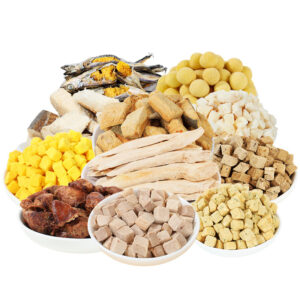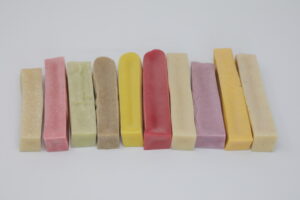As pet parents, we want to give our dogs treats that are not only enjoyable but also safe, healthy, and worth the price. With so many chew options on the market—yak chews, rawhide, bully sticks, Chicken feet, antlers, dental chews, and synthetic bones—how do you choose the right one?
In this guide, we’ll break down the most popular types of chews and how they compare to yak chews, so you can make an informed decision.
🧀 1. Yak Chews
Overview:
Hard, natural cheese chews made from yak and cow milk, lime juice, and a pinch of salt. Traditionally made in the Himalayas.
Pros:
- Long-lasting for moderate to heavy chewers
- Fully digestible
- Odor-free and mess-free
- High in protein and calcium
- Vegetarian, grain-free, low-fat
- good for sensitive tummies (lactose free)
- fully consumable (leftover bits can be microwaved into crunchy treats)
Cons:
- Hard texture may be difficult for puppies or seniors
- Pricier than some chews
Best For:
Dogs over 12 weeks , moderate to aggressive chewers, owners who want natural, clean chews
🦴 2. Rawhide
Overview:
Made from the inner layer of cow or horse hides, often chemically processed and bleached . Byproduct of the leather industry.
Pros:
- Cheap and widely available
- Keeps dogs busy
- Variety of shapes and sizes
Cons:
- Poorly digestible (can cause GI blockages)
- May contain harmful chemicals
- Often coated in artificial flavors or preservatives
- Choking hazard if swallowed in large chunks
Best For:
WE DO NOT SELL OR RECOMMEND RAWHIDE AS THERE HAVE BEEN MANY CASES OF SERIOUS GI BLOCKAGES.
🐂 3. Bully Sticks
Overview:
Single-ingredient chews made from dried bull or steer pizzle (yes, really).
Pros:
- Fully digestible
- High in protein
- Single-ingredient (great for food sensitivities)
- Usually palatable for picky dogs
Cons:
- Strong odor (some brands more than others)
- Can become sticky/greasy
- Pricier for larger sizes
- May not last long with aggressive chewers
Best For:
Light to moderate chewers, dogs with food sensitivities
🐔 Chicken Feet
Overview:
Chicken feet are just what they sound like — the feet of chickens, usually dehydrated for safe consumption.
Pros:
- Fully edible and digestible
- Crunchy and satisfying to chew
- Naturally rich in glucosamine and chondroitin, which support joint health
- Their crunchiness helps scrape off plaque and tartar — making them a natural toothbrush in snack form.
- Grain-free and natural — perfect for dogs with sensitive stomachs or allergies.
Cons:
- Not suitable for Dogs with poultry allergies
- Does not last long , especially for aggressive chewers
- Puppies under 4 months (choking risk)
Best for :
- Small to medium breeds
- Senior dogs needing joint support
- Dogs who love crunchy treats
- Pet parents looking for natural, single-ingredient snacks
🦌 5. Antlers
Overview:
Naturally shed deer, elk, or moose antlers, cut into sizes for dogs.
Pros:
- Extremely long-lasting
- High in minerals (calcium, phosphorus)
- No odor or mess
Cons:
- Very hard—can crack or break teeth
- Not digestible (meant for gnawing, not swallowing)
- Can splinter over time
Best For:
Adult dogs with strong teeth, heavy chewers (with supervision)
🪥 6. Dental Chews
Overview:
Manufactured chews designed to reduce plaque and tartar buildup.
Pros:
- Easy to digest (depending on brand)
- Formulated to clean teeth
- Some offer vitamins or breath fresheners
- Soft enough for seniors or small dogs
Cons:
- Highly processed
- Often contain artificial ingredients
- May not last long—more of a snack than a true chew
Best For:
Daily dental maintenance, light chewers, dogs with sensitive teeth
🦷 7. Nylon or rubber Bones (Synthetic Chews)
Overview:
Hard plastic-based bones flavored to taste like meat, bacon, peanut butter, etc.
Pros:
- Long-lasting
- Cheap
- Comes in a wide range of flavors, textures, and sizes
Cons:
- Not edible or digestible
- Can break off in sharp shards
- Plastic consumption can irritate stomach or cause blockages
- Not natural
Best For:
Strong chewers that are heavily supervised—but still considered high-risk
🏆 Final Comparison Summary
| Chew Type | Digestibility | Durability | Cleanliness | Odor | Natural? | Safe for Daily Use? |
|---|---|---|---|---|---|---|
| Yak Chews | ✅ High | ✅ High | ✅ Very clean | ✅ None | ✅ Yes | ✅ Yes |
| Rawhide | ❌ Low | ✅ Medium | ❌ Messy | ⚠️ Mild | ❌ No | ❌ No |
| Bully Sticks | ✅ High | ⚠️ Medium | ❌ Messy | ❌ Strong | ✅ Yes | ⚠️ Occasionally |
| Chicken Feet | ✅ High | ❌ Low | ❌ Greasy | ⚠️ Mild | ✅ Yes | ✅ Yes |
| Antlers | ❌ None | ✅ Very High | ✅ Very clean | ✅ None | ✅ Yes | ⚠️ Rarely (tooth risk) |
| Dental Chews | ✅ Medium | ⚠️ Low | ✅ Clean | ✅ Low | ❌ No | ✅ Yes |
| Nylon Bones | ❌ Not edible | ✅ High | ✅ Clean | ⚠️ Artificial | ❌ No | ❌ No |
👩⚕️ So, What Should You Choose?
If you’re looking for a chew that is:
- Natural
- Long-lasting
- Digestible
- Low-odor and low-mess
👉 Then yak chews are one of the best all-around options available today.
They’re especially great for pet parents who want to ditch chemicals and odors without sacrificing durability.
🛒 Try the Difference for Yourself
We offer ethically sourced, hand-pressed yak chews made in small batches in Nepal—no fillers, no shortcuts, just pure cheesy goodness your dog will love.




